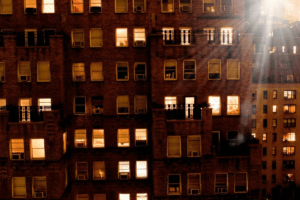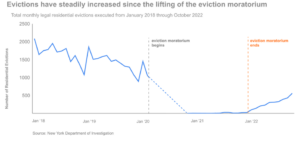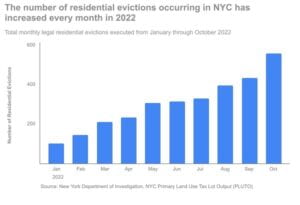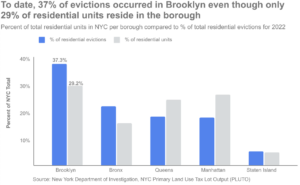The number of evictions occurring in NYC has increased every month in 2022

Across the United States, communities are facing a housing affordability crisis. This crisis is especially acute in New York City, where economic inequality has been widening for years as economic growth for the top income earners has been coupled with stagnating wages, rising rents, and a reduction in availability and deterioration of public housing. These challenges have been exacerbated by the COVID-19 pandemic, which deepened economic and social inequalities. The result of these factors is twofold: first, we are now seeing a housing rental market in NYC experiencing historic rises in rental rates across the boroughs, and second, thousands of tenants are burdened by back rent that they accrued during the pandemic (and many are still facing employment instability). These dynamics are leading to evictions and displacements across all five boroughs at an accelerating rate.

The pandemic laid bare the costs of inequality and the fragility of New York’s socio-economic ecosystem, including unequal health, educational, employment, and housing outcomes. Many policies, like the eviction moratorium, seemingly acknowledged the role stable housing has in public safety and economic recovery. However, in January of this year, lawmakers allowed the eviction moratorium to expire and began a citywide rise in residential evictions. In fact, according to an analysis of data provided by the New York City Department of Investigation (DOI), the number of evictions has steadily increased every month in 2022, signaling a heightening in the eviction crisis plaguing the city. The number of legal residential evictions executed throughout the city has hit the highest level since the start of the COVID-19 pandemic. According to the DOI data, the number of legal residential evictions in August 2022 reached 649, up from 103 in January 2022. This upward trend in residential eviction numbers can be seen monthly through October 2022.

As the eviction rate continues to grow, the fallout and implications of evictions for families and communities are severe. In addition to the loss of their home, families are often forced to relocate to a new neighborhood, so their children must switch schools. The eviction stays on an individual’s legal record, often making it much more difficult to find another apartment to rent. Studies have also shown that employees who have experienced an eviction are 11-15 percent more likely to lose their job than their colleagues.

Most legal residential evictions executed each month this year have occurred in Brooklyn. According to data provided by the NYC Department of City Planning, while Brooklyn has 29% of the total residential units in NYC, over 37% of evictions have occurred in the borough this year. One cause for this disparity is the rise in rents across boroughs. Brooklyn is experiencing significant rises in rents, second to only Manhattan. In Brooklyn, rental prices are reaching historic highs, with the average listing price topping $3,822 for a two-bedroom apartment in June, up from $3,185 in June 2021. As rental prices continue to surge in Manhattan, tenants are looking to other boroughs for relatively lower rents, increasing housing demand and displacement pressure on Brooklyn. For example, according to data from StreetEasy to CityLimits, the median rent in Brooklyn increased by 24.6% for a two-bedroom rental unit from August 2019 to August 2022.
An effective initiative in protecting tenants from eviction is NYC’s Right to Counsel law, which mandates the city to provide low-income tenants (tenants with incomes below 200% of the federal poverty level) with legal representation in housing court. However, since the ending of the eviction moratorium, only 10% of tenants received legal counsel in housing court. Legal representation in housing court has proven to be a powerful tool in fighting evictions and homelessness. The NYC Office of Civil Justice (OCJ) found during an initial test period of the program that 84% of tenants represented by a lawyer in their eviction case were allowed to stay in their homes. The city must prioritize connecting qualifying tenants to lawyers to combat the rising rate of evictions across the city and create a more equitable and just housing system.
Affordable housing is paramount to addressing and alleviating inequality. Studies have shown that a lack of affordable housing increases housing instability and worsens disparities in healthcare, educational outcomes, social and economic mobility, employment stability, and resource access. Interventions like the eviction moratorium slowed the upward trend of evictions and prevented them from reaching pre-pandemic levels. But as evictions continue, we need additional steps like stronger tenant protections allowing tenants to challenge exorbitant rent increases, investing in more affordable housing, and ensuring that housing initiatives throughout the city reach the most vulnerable households. Increasing affordable housing availability and promoting tenant rights are essential for the city’s post-pandemic economic recovery efforts and for ensuring future economic development.
You can reach the author of this piece, Dori McAuliffe, at: dom4206@nyu.edu
You can reach the editor of this piece, Patrick Spauster, at: ps4375@nyu.edu